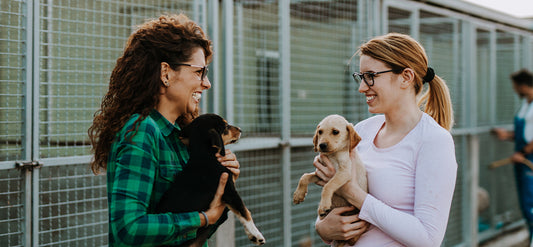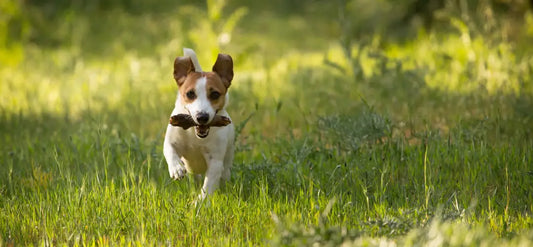Just as change can be challenging for us humans, our canine companions also find it tough. Approximately 20% of dogs experience separation anxiety when their owners return to work or school after a period of being home. Whether it's the kids going back to school, a new family member causing a stir, or another pet joining the pack, these shifts can leave your pup feeling unsettled. But fear not, faithful dog parent, we've got the tips to help you guide your pooch through these transitions with ease and confidence.
Understanding How Dogs Handle Change
Just like humans, dogs are creatures of habit. Any disruption to their daily routine can trigger anxiety and stress. According to a 2010 study published in the Journal of Veterinary Behavior, dogs who experienced changes in their environment displayed more signs of stress compared to dogs in stable environments.1
"Dogs, like people, are creatures of habit and routine, and any change - whether it's a major life event or even a minor deviation - can cause them stress," says Dr. John Ciribassi, past president of the American Veterinary Society of Animal Behavior.2
A survey by the PDSA, the UK's leading veterinary charity, found that 82% of dogs show visible signs of stress when their routine is upset. Signs can range from barking and whining to more destructive behaviors like chewing and digging.3
It's clear from these findings that our furry friends are profoundly affected by changes in their lives. In the following sections, we'll explore strategies to help your dog navigate these changes more comfortably.
How to Spot Signs of Stress in Your Dog
As dog owners, we have to be the detectives of our furry friend's feelings. Canines, just like us, cope with stress and change in their unique ways, often exhibiting distinct physical and behavioral signs. Understanding these signs is crucial to helping them manage change.
- Decreased Appetite: A stressed dog might lose interest in food or start eating significantly less.
- Isolation: Dogs might seek solitude, hiding in their favorite spots more often than usual.
- Destructive Behavior: Your usually well-behaved pup might start chewing furniture, shoes, or other objects around the house.
- Increased Agitation: A stressed-out dog can become more aggressive or unusually active.
- Excessive Barking: Too much barking or whimpering can be a sign of stress or anxiety.
- Changes in Sleeping Habits: Like humans, dogs can experience sleep disturbances when they're stressed, leading to increased sleepiness or insomnia.
The Importance of Routine for Your Dog
Just like us, dogs thrive on routine. Our furry friends adore predictability; it gives them a sense of security and helps reduce their stress levels. Breaking their routines, on the other hand, can make them anxious and may lead to behavioral issues.
Regular feeding times, consistent walks, and predictable playtimes are not just part of spoiling them; they're integral to their mental health too. Routines also help them understand what's expected of them, which can make training easier.
But what happens when these routines are disrupted? How can you help your furry friend navigate the unexpected changes that life often brings? Let's delve into the nitty-gritty of managing change with your canine companion.
Preparing Your Dog for Schedule Changes
When your home schedule changes, it can throw your canine companion into a tailspin. Whether it's the kids returning to school or a parent going back to the office, your dog might not be ready for this shift. But, fret not! There are steps you can take to ease your furry friend into this transition.
- Gradual Adjustment: Start by slowly adjusting your dog's routine to mirror the impending changes. If you're going back to work, begin by leaving your dog alone for short periods, and gradually increase this time.
- Exercise: A good workout can help manage your dog's energy levels and anxiety. Try to fit in a walk or playtime before the household schedule shifts.
- Comfort Objects: Leave out familiar toys or bedding. Familiar scents can provide comfort during your absence.
- Positive Associations: Make your departure a positive experience by giving your dog a treat or a new toy right before you leave. This can help your pet associate your absence with positive experiences.
Remember, patience is key. These changes might be confusing for your dog initially, but with time, they will adapt to the new routine. After all, change is a part of life, even for our four-legged friends.
How to Introduce Your Dog to a New Family Member
Much like us, dogs are creatures of habit, and bringing a new family member into the home can seriously ruffle their fur. Whether it's an infant or an elderly relative, these introductions require delicacy and patience. But fret not! Here are some handy steps to make the transition smoother for your dog.
- Prepare in advance: Before the new family member arrives, let your dog sniff an item belonging to them. This familiarizes their scent and makes the introduction less startling.
- Maintain a routine: Dogs thrive on consistency. As much as possible, keep their feeding, walking, and playtime schedules intact to prevent anxiety.
- Control the introduction: Make sure the dog is calm when they first meet the new family member. If it's a baby, keep them in a safe place, like a car seat or crib. For elderly family members, ensure they are seated and comfortable.
- Positive reinforcement: Reward your dog for good behavior around the new family member. Treats, praise, or a favorite toy can encourage positive interactions.
- Gradual exposure: Don't force them to spend too much time together at first. Gradually increase their time spent together to allow them to adjust at their own pace.
Remember, every dog is unique and might respond differently to change. Don't rush the process and always keep an eye on their behavior. In time, your dog will not just adjust, but thrive in their refreshed pack!
Helping Your Dog Adjust to a New Pet in the House
Bringing a new pet into your home is an exciting change, but your dog may not immediately see it that way. Here's a positive approach to help your furry friend adjust.
- Introduce them gradually: Don't just thrust the new pet into your dog's space. Start with short, supervised meetings and gradually increase their time together.
- Respect your dog's territory: Your dog may feel threatened if the new pet invades their space. Arrange separate areas for each pet initially, and only allow shared space under supervision.
- Stay neutral: Avoid showing favoritism to the new pet. This could make your dog feel neglected and increase their resistance to the newcomer.
- Keep routines consistent: Try keeping your dog's routine - feeding times, walks, playtime - the same as it was before the new pet arrived.
According to the American Kennel Club, it's important to monitor the body language of both pets during interactions. Signs of aggression or fear need to be addressed immediately.
If you notice signs of fear or aggression, such as growling, showing teeth, or excessive barking, it's essential to intervene calmly and assertively. Separate the dogs and give them time to cool down before attempting to reintroduce them in a neutral and controlled environment. Remember, patience and consistency are key in helping your pets adjust to one another.
Helping Your Dog Deal with the Loss of a Family Member
When a beloved family member leaves the house for an extended period, like heading off to college, or in more heartbreaking situations such as a loved one passing away, our furry friends can feel the impact. Research indicates that dogs can undergo grief and depression after the loss of a family member or pet companion.
Studies have shown that dogs can experience grief and depression after the loss of a family member or pet companion.
But here's the good news - you can help your dog navigate through these changes. It's all about providing extra care, understanding, and patience. Let's explore some ways to help your dog adjust.
- Keep a consistent routine: Dogs thrive on routine. Try to keep their mealtimes, walks, and playtimes as regular as possible.
- Provide plenty of exercise: Physical activity can help to alleviate stress and anxiety in dogs.
- Offer extra affection: Increased cuddle time and showing more love can provide comfort and reassurance.
When to Seek Professional Help for Your Dog
There comes a time when despite your best efforts, your furry friend may still struggle to cope with significant changes. Understanding when to seek professional help is crucial, as prolonged distress can lead to behavioral issues or even health problems. Here are some signs that indicate it might be time to bring in a professional dog behaviorist or a vet.
- Drastic Changes in Behavior: If your dog suddenly starts displaying aggressive behaviors, becomes excessively clingy, or begins to ignore commands, it might signal that they're seriously struggling with the change.
- Changes in Eating Habits: A sudden lack of appetite or an increase in food consumption could be a sign of stress or anxiety.
- Disrupted Sleep Patterns: If your dog is having trouble sleeping, wakes up frequently, or starts to sleep more than usual, it could indicate that they're not adjusting well to new routines or environments.
- Excessive Grooming: Dogs often groom excessively when they're anxious or stressed. If your dog starts to lick or chew their fur more than usual, it's worth seeking professional help.
Remember, these signs don't always mean that your dog is not coping well with change. They could also be indicators of underlying health issues. Therefore, it's essential to consult a vet or a professional dog behaviorist to establish the cause and find a solution.
It's always better to be safe than sorry. Your dog's wellbeing should always be your primary concern. Don't hesitate to reach out to professionals if you notice any unusual behavior. They can provide guidance and help your dog navigate through the change more effectively.
Choosing the Right Professional
Selecting the right professional to help your dog can be a challenge. It's important to find someone who not only understands canine behavior but also has experience dealing with the specific issue your dog is facing. Here are a few things to consider when choosing a dog behaviorist or a vet:
- Experience: Look for professionals who have substantial experience dealing with dogs and understand various dog behaviors.
- Specialization: If your dog is exhibiting a specific problem, like aggression or anxiety, find a professional who specializes in that area.
- Reputation: Always check reviews and ask for references before choosing a professional.
- Comfort For Your Dog: Your dog must feel comfortable with the professional. Therefore, it's worth having an initial meeting to see how your dog reacts to them.
Helping your dog manage change can be a challenging task, but with patience, love, and the right professional assistance, it can be done. Always remember, every dog is unique and will react differently to change. Stay observant and supportive, and your pup will be back to their old self in no time.
1 Journal of Veterinary Behavior (2010)
2 Dr. John Ciribassi, American Veterinary Society of Animal Behavior
3 PDSA Animal Wellbeing Report (2019)



